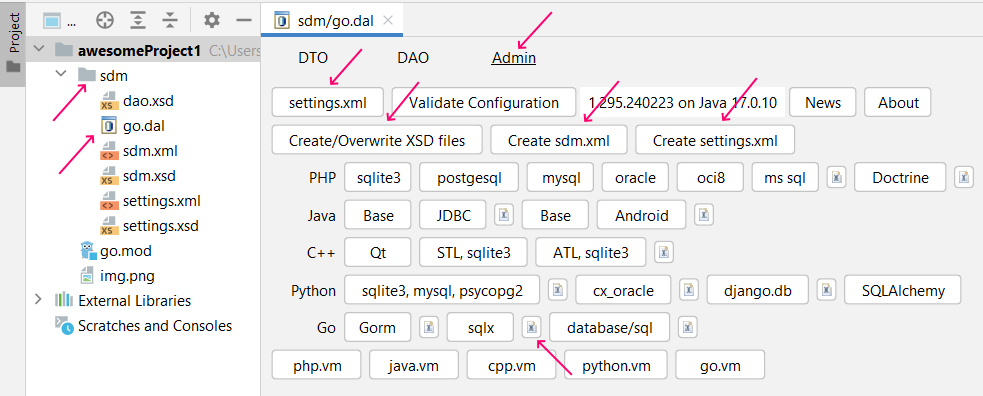^ Files of XML Meta-Program
A-folder-in-the-project-tree |--- go.dal root-file: an empty file named as 'php.dal', 'java.dal', 'cpp.dal', 'python.dal', or 'go.dal' (ensure lower case) |--- sdm.xml declarations of DTO/model and/or DAO classes |--- settings.xml common settings |--- sdm.xsd ------ XSD-files for XML code completion and parsing |--- settings.xsd ------ |--- dao.xsd ------ |--- ProjectsDao.xml external XML files as an option to declare DAO classes
Initial Steps

- Create/Open an SDM folder (any name)
- Create/Open (double-click) a root-file to enter the Plug-in GUI, switch to "Admin"
- Create XSD files, "sdm.xml", and "settings.xml".
- Click "settings.xml" to start editing. Read and follow the notes in XML comments. Save the changes.
- The buttons marked as [x] may be good starting points.
Real examples of "settings.xml" are available in Demo Projects.
This is a typical one (Android): https://github.com/panedrone/sdm_thesaurus_android/blob/master/sdm/settings.xml
See also a Quick Demo Video.
^ settings.xml -> examples of JDBC settings
| JDBC Driver | XML tag in 'settings.xml' |
| MySQL | <jdbc jar="lib/mysql-connector-java-8.0.13.jar" class="com.mysql.cj.jdbc.Driver" url="jdbc:mysql://localhost/sakila" user="root" pwd="root"/> |
| Oracle | <jdbc jar="lib/ojdbc8.jar" class="oracle.jdbc.driver.OracleDriver" url="jdbc:oracle:thin:@localhost:1521:orcl" user="ORDERS" pwd="sa"/> |
| PostgreSQL | <jdbc jar="postgresql-42.2.9.jar" class="org.postgresql.Driver" url="jdbc:postgresql://localhost:5432/orders" user="postgres" pwd="sa"/> |
| SQL Server | <jdbc jar="mssql-jdbc-8.2.2.jre11.jar" class="com.microsoft.sqlserver.jdbc.SQLServerDriver" url="jdbc:sqlserver://localhost\SQLEXPRESS;databaseName=AdventureWorks2014" user="sa" pwd="root"/> |
| xerial / sqlite-jdbc | <jdbc jar="sqlite-jdbc-3.40.0.0.jar" class="org.sqlite.JDBC" url="jdbc:sqlite:$PROJECT_DIR$/northwindEF.sqlite" user="" pwd=""/> |
| H2 | <jdbc jar="h2-1.4.190.jar" class="org.h2.Driver" url="jdbc:h2:$PROJECT_DIR$/h2_orders" user="" pwd="" /> |
^ settings.xml -> type-map
Here you specify how the types detected by code generator are rendered in the target code.
<type-map default="">
<type detected="java.lang.Integer" target="int64">
<type detected="java.lang.Double" target="float64">
<type detected="java.lang.Float" target="float64">
<type detected="java.lang.String" target="string">
<type detected="byte[]" target="[]byte"/>
<type detected="java.lang.Object" target="interface{}"/>
</type-map>Algorithm of processing is the following:
- if detected type is found among 'detected', then related 'target' is rendered
- if not, then 'default' is rendered
- if 'default' is empty, detected type is rendered as-is.
If you want to create "type-map" from zero, read this: misc.html#type-map.
if you need more strong typing in generated DAO classes, read this: misc.html#strong-typing.
There may be some nuances depending on database/driver.
Example 1. MySQL JDBC driver detects all field types correctly. At the same time, MySQL divers for Go fetch all values as []uint8:
Example 2. Oracle JDBC driver detects all numerics as "java.math.BigDecimal". At the same time, Go + "github.com/godror/godror" fetches all numerics as strings:
Example 3. For Java + Android + SQLite, you may need this:
<type-map default="">
<!-- On Dev. PC, it is Integer, but in Android run-time it is Long -->
<type detected="java.lang.Integer" target="java.lang.Long"/>
</type-map>
Example 4. JDBC driver for SQLite3 detects date/time as "java.lang.String" or "java.lang.Object",
but it happens that Go + "github.com/mattn/go-sqlite3" fetches date/time as "time:time.Time".
In such cases, 'type-map' may be not working, and you need explicit declarations:
<dto-class name="Orders" ref="get_orders.sql">
<field type="time:time.Time" column="o_date"/>
</dto-class>^ settings.xml -> macros
To generate complex fields like in example below
class Task(Base):
__tablename__ = 'tasks'
t_id = Column('t_id', Integer, primary_key=True, autoincrement=True)
g_id = Column('g_id', Integer, ForeignKey('groups.g_id'))
t_priority = Column('t_priority', Integer)
t_date = Column('t_date', String(65535))
t_subject = Column('t_subject', String(65535))
t_comments = Column('t_comments', String(65535))
you will need to extend the section "settings.xml" => <macros> and use related references in "settings.xml" => <type-map><type ... target="...:
<type-map default="">
<type detected="sa-java.lang.Integer" target="${sa-type}|0:Integer"/>
<type detected="sa-java.lang.Float" target="${sa-type}|0:Float"/>
<type detected="sa-java.lang.String" target="${sa-type}|0:String"/>
<type detected="sa-byte[]" target="${sa-type}|0:LargeBinary"/>
<type detected="sa-java.lang.Object" target="${sa-type-unknown}"/>
type-map>
<macros>
<macro name="${sa-type-unknown}" value="${sa-column-base}|type:"/>
<macro name="${sa-type}" value="${sa-column-base}|type:, ${0}"/>
<macro name="${sa-column-base}"/>
<vm/>
<![CDATA[= Column('${column}'${type}#if($fi.ColumnSize>0)($fi.ColumnSize)#end#if($fi.FK), ForeignKey('$fi.FK')#end
#if($fi.PK), primary_key=True#end
#if($fi.AI), autoincrement=True#end
#if(!$fi.PK)
#if($fi.Indexed), index=True#end
#if($fi.Unique), unique=True#end
#if($fi.Nullable), nullable=True#end
#end)${comment}]]/>
</vm/>
</macro/>
macros>Examples of the field-related macros are available in plug-in GUI => tab "Admin" => [X] and in Demo-Projects: https://github.com/panedrone/sqldalmaker
To customize class-based macros, use this:
-
refs to entries of section <macros>:
<dto scope="" inheritance="" field-names-mode="0" macro="${dto}"/> <dao scope="" field-assign-mode="0" macro="${dao}"/> -
refs to external files:
<dto scope="" inheritance="" field-names-mode="0" macro="sdm/python.models.vm"/> <dao scope="" field-assign-mode="0" macro="sdm/python.dao.vm"/>
^ Areas of Responsibility
- Generated Code is free of direct calls to an underlying DB accessing API (PDO, JDBC, QtSql, etc.)
- Such calls are wrapped inside an outer Proxy class
- Generated Code performs DB-related operations by calling Proxy via an ordinary interface DataStore
Example below is to demonstrate how to organize it in Golang:
- Proxy and DataStore: https://github.com/panedrone/sdm_todolist_go_react_vue_npm_sqlite3/blob/master/sqlx/dbal/data_store_sqlx.go
- Usage in Generated Code: https://github.com/panedrone/sdm_todolist_go_react_vue_npm_sqlite3/blob/master/sqlx/dbal/projects_dao.go
For more examples, refer Demo-Projects and the plugin GUI, tab 'Admin'.
| Underlying DB accessing API | Comments | |
|---|---|---|
| PHP | MySQL, Oracle, PostgreSQL, SQL Server, SQLite3 | |
| Java |
Available through JDBC: MySQL, Oracle, PostgreSQL, SQL Server, SQLite3, H2, HSQLDB, Derby, IBM DB2, IBM Informix, Firebird, etc. |
|
| C++ | Databases supported by Qt: http://doc.qt.io/qt-5/sql-driver.html | |
| Python | - | |
| Go | Tested with MySQL, Oracle, PostgreSQL, SQL Server, and SQLite3. |
